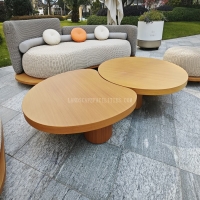Welcome to the website for landscape facilities products and knowledge.
What are the most important considerations for ensuring the table’s stability when used with casters?
When equipping a table with casters, ensuring stability is paramount for both safety and functionality. A wobbly or tipping table can lead to accidents, damage, and inefficient workflow. To achieve optimal stability, several critical factors must be considered.
First and foremost is the selection of the casters themselves. The caster's load capacity is the foundational element. You must calculate the total weight of the table itself, plus the maximum load it is expected to carry. The combined load capacity of all casters should significantly exceed this total weight—a common safety margin is 25-30%. This prevents overloading and ensures smooth, stable movement.
The material and hardness of the caster wheel are equally important. Soft wheels, like those made from polyurethane or rubber, provide excellent grip and vibration absorption, making them ideal for protecting delicate floors like hardwood or tile. However, for extreme heavy-duty applications or rough surfaces, harder wheels like nylon or phenolic may offer greater durability and easier rolling, though with less floor protection.
The base plate or stem mounting system that attaches the caster to the table is a key component of stability. The base plate must be sufficiently large and made of strong material, such as steel, to distribute the load evenly. It should be securely fastened with multiple bolts, not just screws, to the table's leg. A weak attachment point is a primary cause of instability and potential failure.
The design and construction of the table itself cannot be overlooked. A table with a wide, heavy base and a low center of gravity is inherently more stable than a tall, narrow one. The mounting points for the casters should be reinforced, especially on wooden tables, to prevent the wood from splitting under stress. For added security, consider using casters with a locking mechanism. Swivel locks prevent the wheel from rotating and the caster from swiveling, effectively turning the mobile table into a stationary one when needed. This is crucial for tasks that require precision and no movement.
Finally, consider the operating environment. The floor surface plays a significant role. Casters perform differently on carpet, concrete, epoxy, or uneven surfaces. Larger diameter wheels are better for navigating bumps and transitions between floor types. Regular maintenance, such as checking for loose bolts and cleaning debris from the wheels and swivel mechanisms, will also preserve long-term stability and performance.
By carefully evaluating the caster's load rating, wheel material, mounting system, table design, and the specific environment, you can ensure your table remains stable, safe, and fully functional on the move. Never compromise on these considerations for the sake of mere mobility.
Related search:

Recommendation
Elliptical metal outdoor table with nested design, resembling wood grain, round table